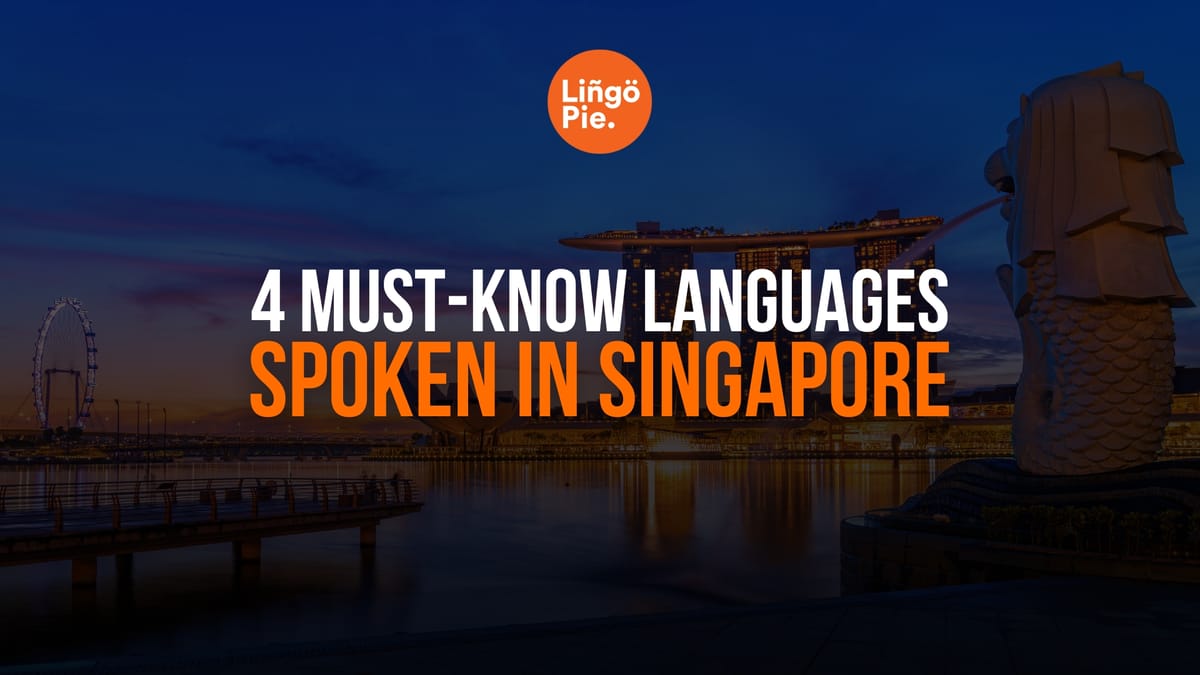Ever found yourself staring blankly at a Singapore hawker stall menu, wondering what "kopi C siew dai" actually means? Or had a taxi driver switch between three languages in a single conversation while you just smiled and nodded? Well, you really are IN Singapore!
Singapore has four official languages (English, Mandarin, Malay, and Tamil), but most people aren't fluent in all of them. Instead, Singaporeans strategically switch languages depending on who they're talking to and what they're doing. I'll show you exactly which languages matter where, plus give you the essential phrases that'll seriously surprise locals.
- 9 Chinese Jokes That Made Me Feel Fluent In Chinese
- 70+ Common Chinese Last Names And Their Meanings
- Best Way To Learn Chinese: Techniques For Mandarin

Why Singapore Has Multiple Languages?
Singapore's multilingual identity comes directly from its history as a trading hub where different cultures met. Chinese merchants, Malay traders, Indian workers, and British colonizers all brought their languages to this tiny island, creating a linguistic melting pot that still thrives today.
Singapore officially recognizes four languages: English, Mandarin Chinese, Malay, and Tamil. English works as the common language for everyday life, government, legal matters, and business. This approach helps keep the cultural roots of Singapore's main ethnic groups alive while giving everyone a way to talk to each other.
Today, this mix of languages is one of Singapore's biggest strengths. About 75% of Singaporeans speak at least two languages, way more than in countries like the UK or US, giving the country big advantages in international business, education, and relations with other countries.

Official Languages In Singapore
English
English is the main language in Singapore, used in schools, business, and government. About 48.3% of Singaporeans speak English as their first language, but many more use it as their second language since it connects all the different ethnic groups.
Why is English so common? When Singapore became independent from the British Empire in 1965, the government chose to focus on English because:
- It was neutral and didn't favor any particular ethnic group
- It connected Singapore to global business
- It gave access to worldwide knowledge in science and education
Another thing worth noticing is that Singapore mostly uses British English rather than American English, showing its history as a British colony. But Singaporeans have created their own special version called Singlish (more on that later!).
Common English phrases with a Singapore twist:
- "Can" - A useful word meaning yes, it's possible, or I agree
- "Got already" - Confirming something is done or received
- "No need" - It's not necessary
Mandarin
Mandarin Chinese is another key language in Singapore. It's the first language for about 30% of Singaporeans, mainly those of Chinese background who make up the largest ethnic group.
Since the 1970s, Singapore's government has pushed for more Mandarin use through programs like the "Speak Mandarin Campaign." This campaign started in the late 1970s, around the time China was opening up economically, to help Chinese Singaporeans unite under one language instead of speaking various regional dialects.
As China's economy has grown, Mandarin has become more valuable for business and trade throughout Asia.
Common Mandarin phrases used in Singapore:
- 你好 (Nǐ hǎo) - Hello
- 谢谢 (Xiè xiè) - Thank you
- 再见 (Zài jiàn) - Goodbye
- 多少钱 (Duō shǎo qián) - How much is it?
- 我听不懂 (Wǒ tīng bù dǒng) - I don't understand
Malay
Malay is Singapore's national language and ceremonial language, even though it's not the most widely spoken. About 13% of Singaporeans speak Malay as their first language, mostly those from Malay backgrounds.
Why is Malay the national language? It honors Singapore's history with the Malay region and its original communities. The national anthem, "Majulah Singapura" (Onward Singapore), is sung in Malay, showing its cultural importance.
Many Malay words have become part of everyday Singapore talk, especially in Singlish, showing how languages naturally mix in this multicultural place.
Common Malay phrases used in Singapore:
- Selamat pagi - Good morning
- Terima kasih - Thank you
- Makan - Eat (widely used in Singlish)
- Alamak! - Oh my goodness! (when surprised)
- Chope - To save a spot (like putting tissues on a table to reserve a seat)
Tamil
Tamil is the fourth official language of Singapore, representing the Indian community. Tamil uses its own script (also known as Dhamili) and is widely spoken by Indians living in Singapore. While the number of native Singaporean Tamil speakers has gone down over the years, it remains an important official language.
According to the 2020 census, about 9% of Singaporeans were of Indian origins, with about 36.7% of them speaking Tamil most often at home. Tamil is taught in schools and used in official communications, helping keep Tamil culture alive in Singapore.
While Tamil is the main Indian language officially recognized, other Indian languages like Hindi, Punjabi, and Bengali are also spoken within the community.
Common Tamil phrases used in Singapore:
- வணக்கம் (Vanakkam) - Hello
- நன்றி (Nandri) - Thank you
- சாப்பிட்டீர்களா (Saapteengala) - Have you eaten?
- ஒரு நிமிஷம் (Oru nimisham) - One moment
- உங்க பேரு என்ன? (Unga peru enna) - What's your name?
What Is Singlish?
Singlish is a casual form of English that mixes in words from other languages spoken in Singapore, like Malay, Hokkien, Cantonese, and Tamil. It has its own slang, expressions, and grammar that might sound strange to people who speak standard English.
What makes Singlish special is how it borrows words and grammar from all of Singapore's main languages, creating something that's 100% Singaporean. While the government has tried to promote standard English through the "Speak Good English Movement," many Singaporeans are proud of Singlish as part of their identity and keep using it in casual conversations.
Common Singlish Features
Words added to the end of sentences: "Lah," "leh," "lor," and "meh" that add feeling and meaning
- "Just do it like that lah" (showing frustration or finality)
- "I didn't know you have to do it like that leh" (showing uncertainty)
- "I've got no choice, so I just did it lor" (showing acceptance)
Words from multiple languages:
- "Shiok" - Delicious or excellent (from Malay)
- "Kiasu" - Afraid of missing out (from Hokkien)
- "Bo chap" - Don't care (from Hokkien)
Different grammar patterns:
- Skipping words: "You want coffee?" instead of "Do you want some coffee?"
- Asking questions: "Can or not?" instead of "Is it possible?"
- Repeating words: "Don't play-play" (Don't mess around)
Other Foreign Languages in Singapore
Beyond the four official languages, Singapore's global outlook has attracted speakers of many other languages. Walk through the CBD (Central Business District) or visit expat enclaves like Holland Village, and you'll hear languages from across the globe.
Japanese, Korean, and French communities have established presences in Singapore, bringing their languages and cultures. You'll find international schools teaching in these languages, restaurants with menus in multiple languages, and cultural events celebrating linguistic diversity.
The financial and tech sectors have also drawn professionals from around the world. Many multinational companies operate in Singapore, creating office environments where you might hear Spanish, German, or Russian alongside the official languages.
Foreign language learning is also popular among Singaporeans themselves. Many schools offer European and Asian languages as elective subjects, with Japanese and French being particularly popular choices. This openness to language learning reflects Singapore's commitment to staying globally connected.
For visitors and new residents, this means Singapore is usually accommodating of different languages. While English remains the main bridge language, don't be surprised to find staff in hotels, restaurants, and shops who can speak several languages to serve international clients.

Working In Singapore
If you're thinking about working in Singapore, here's the good news: knowing English is enough to get by in most professional settings. But learning some basics in the other main languages can give you some real advantages:
- Building relationships: Greeting coworkers in their native language shows respect
- Business opportunities: Speaking Mandarin helps with China-related business
- Customer service: Understanding Singlish helps you connect with local customers
- Fitting in better: Knowing local languages helps you enjoy Singapore's cultural events
Singapore's education system teaches students both English and their "mother tongue" based on their ethnic background. This helps Singaporeans connect globally through English while keeping their cultural roots through their heritage language.
Picking Up Singapore's Languages Today
Want to learn Mandarin to better connect with Singapore's Chinese community? Lingopie currently focuses on Mandarin Chinese, the most widely spoken language in Singapore after English. Through Lingopie's educational streaming content, you can learn real, everyday Mandarin as it's actually spoken.
Lingopie's advanced features to language learning through entertainment works really well for understanding Mandarin in natural settings. You can:
- Watch shows with authentic Mandarin to hear the language as it's really used
- Learn while being entertained instead of reading boring textbooks
- Get used to different accents and speaking styles
- Understand cultural references that textbooks don't teach
This immersive way of learning helps you pick up not just words and grammar, but also cultural nuances that are key for real communication in Singapore's Chinese community.






![6 Best Japanese Language Apps Worth Trying [TESTED]](/blog/content/images/size/w300/2025/12/best-apps-to-Learn-Japanese.jpeg)

![A Guide To Kansai-ben Dialect For Beginners In Japanese [2026]](/blog/content/images/size/w300/2025/03/Kansai-ben-dialect.jpg)
